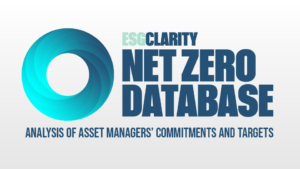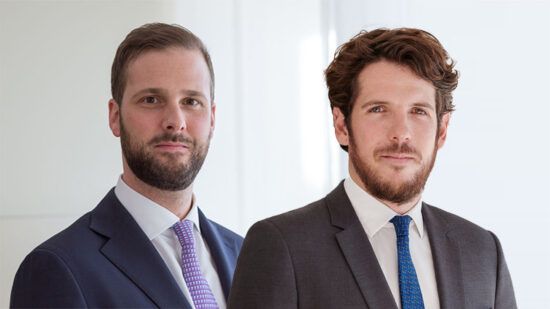Human rights have traditionally sat outside the remit of investors but that is starting to change, thanks to their incorporation in financial regulation, better data and the emergence of frameworks and benchmarks, a panel of experts tells ESG Clarity EU.
Yet despite progress, there are still barriers. Companies ignore requests for responses on allegations of transgressions, Aine Clarke, KnowTheChain project director at the Business & Human Rights Resource Centre tells us. Where they supply insufficient responses, fund managers often aren’t doing enough to push back, Chris Welsford, managing director at Ayres Punchard adds.
But “the harder the people push, the better,” Neil Brown, head of equities at GIB Asset Management, says. “Good fund managers should welcome that.”
The full panel discussion can be viewed in the video above and a transcript is below.
See also: – All ESG Clarity’s COP27 coverage
The panellists:
- Neil Brown, head of equities, GIB Asset Management
- Chris Welsford, managing director, Ayres Punchard
- Paloma Muñoz Quick, global lead, financial services and human rights, BSR
- Aine Clarke, KnowTheChain project director, Business & Human Rights Resource Centre
NT: Hello and welcome. Thank you for joining us for another roundtable in our series running all this week on ESG Clarity EU. I’m global deputy editor Natasha Turner and today I am delighted to be joined by an esteemed panel for a lively, informative and above all poignant discussion about human rights and investment.
This roundtable series is running throughout COP27, so it would really be remiss not to include a conversation about human rights, which should be front and centre of people’s minds during these important negotiations.
Before we get into these conversations about how the investment industry can be tackling human rights concerns, let’s just get a sense of what some of the most pressing issues are right now that are actually realistic for investors to be able to impact and to address.
AC: I’m Aine Clarke, I’m head of KnowTheChain and investor strategy for the Business & Human Rights Resource Centre. With the transition from peak pandemic to new normal, the long-existing inequalities within global supply chains and business practices have been exacerbated by Covid-19, and this has meant severe consequences for already vulnerable workers, including women and migrant workers.
And then new converging crises like global conflict and the cost of living surges, inflation and growing social tensions, further threatens to undermine labour rights across these local supply chains and high-risk sectors, including the garment sector, where both the demand side, as markets in the global north contract, and supply side, as producing countries face national crises. These are illustrative of contexts like Myanmar, Sri Lanka and Pakistan that are going through these kinds of changes.
We are acutely aware of the closing of civic spaces, in particular regions as well, and how businesses are reacting to that in terms their own freedom of association and collective bargaining practices. And so we see these enabling rights as key issues for investors as we go forward.
NT: Paloma, in your work you’ve highlighted some of these issues, right? And you have also found them across sectors and you found them to be issues for many managers and asset owners. And you’ve also found in some of your work that they’re not being addressed. So why are these being overlooked? Why are human rights proposals often voted against? Why is that shift to a different kind of investing not happening by everyone?
PMQ: Thanks, Natasha, my name is Paloma Munoz Quick. I lead BSR’s work at the intersection of human rights and financial services. I advise a wide range of financial actors, including asset owners and managers across asset classes on human rights, on how to embed human rights into their investment practices and so on.
That’s a great question. I would just start by saying that there’s movement there. There is movement in the right direction.
Traditionally there has been far less attention to human rights issues and human rights approaches. And the core reason for that is there has traditionally been a lack of understanding among institutional investors regarding what human rights standards are and then how they relate to ESG investing. And by saying that, I mean both in terms of what do we mean by human rights? Because there’s an issue around the narrow definition of human rights that exist. Maybe it’s modern slavery or maybe it’s some sort of supply chain issue or DEI and not an appreciation of the fact that human rights cut across all civil, political, economic, social, cultural, labour and environmental rights, I mean, we’re talking about a lot of issues.
One issue is a lack of commonality of what human rights are, perhaps. And then secondly, about what a human rights approach means. How do you assess risk to people? What is the methodology that you would use? And I think there are many reasons for that. It has taken the community, the business, the human rights community, which I work in and am from, quite some time to elaborate on standards.
How do you unpack the UN Guiding Principles (UNGPs) on business and human rights for institutional investors? The OECD has done a good job – in 2017 it put out some guidance on that. But more practice, more examples, more everything is needed to help investors really kind of make that shift. And it’s taken a while also for regulatory frameworks and other drivers to align to the human rights-based approach.
But again, I think that’s also changing. Obviously, Europe taking the lead by, for example, integrating human rights standards into the sustainable finance disclosure requirements, forthcoming due diligence regulation. All these things are going to contribute to seeing an uptick in investor engagement on human rights.
NB: Neil Brown, head of equities at GIB. Taking the positive from the advances that we have made I think where we’ve worked well, it has been this financial case, it has been the business case. And quite often the taxonomy is largely looking at the business revenues, products, services, how they make their money. And a lot of these issues, rightly or wrongly, are viewed as below the line.
And when investors look below the revenue line, they start to talk about cost and risk, and that has less of a driver behind it. So I think we have two things happening. One is we’re getting much better at making the business case – a lot of the engagement I’ve done has been around apparel – and I think we’re making the case that a loss of trust in the consumer does translate to an impact on sales, to give it its most basic. And at the same time, investors are starting to ask much deeper questions about being in the service of the end client, the world that they want to inhabit and live in beyond financial returns.
NT: You’ve mentioned financial and social risks, are there other things that come into consideration that people are asking about, such as reputational risks? Are there other things that can help your case?
NB: Yeah and we’ve touched on the taxonomy’s principal adverse indicators. You know, we are tightening up, we are aligning with the brilliant Guiding Principles. This has been a long, slow process – we’re coming up on 10 years since the Rana Plaza [disaster] – but you can’t look back and say there hasn’t been any development. I think we’d all agree we’re not there and we’re looking at acceleration.
As an investor, I will look for not just data and disclosure from companies, but the way it can be aggregated, the way it can be brought into thematic notes, the way that the research that I read incorporates this issue and says this is a better business for all of these issues, not it’s a great business, and we’d also look to these other aspects as a sort of hygiene on a recommendation, but really integrates these issues into understanding the full business case. I think improvements are coming. A social taxonomy will be great should it arrive. Not easy, but neither was the initial taxonomy until we got started.
Issues for investors
CW: I’m Chris Welsford, the managing director of Ayres Punchard. We engage in research into sustainability and impact issues for our own portfolio. We do very deep-dive research and then we issue reports, which we use to engage with fund managers. One of the things that is absolutely clear when we go back and engage with fund managers is that we can engage on environmental issues, we can engage on anti-corruption, but as soon as we start moving into human rights and labour rights, it becomes less easy. And that’s why this is such an interesting debate, because there’s a disjunct between what we see as a threat and what actually is a threat in terms of risk within our portfolios.
And when we come to talk about labour rights, it tends to not focus on the human beings, the individuals, because we can’t imagine a factory in Mexico, for instance. We’re having a discussion in London, the factory in Mexico, these people are completely not joined to us. It’s difficult to have empathy with the working conditions, say, or the fact they’re earning 25% of what a sustainable living wage would be in that country. And that we’ve ended up invested in a company that’s doing that, and we’re having to talk about it, in a way we’d rather ignore it. But it does make a difference and it does create significant risk within the portfolio.
It’s almost because it’s a global issue, it’s such a big issue, that it’s difficult to reduce it down into terms that we can understand.
AC: In terms of the compartmentalisation that you mentioned, in a way it’s needed so that we feel like we can tackle and measure these issues. But, I mean, the ESG framing, I think, is counterproductive in the sense that it splits the human element within this from the environmental elements. This is why we get divergence theories and methodologies and categorisations of ‘S’ and what it means.
What we have at the moment is that we feel like everything to do with people falls under the ‘S’ when in reality, impacts on people can be social, environmental or economic in nature. We see that within the renewable energy sector in particular, which is a focus of the Resource Centre where renewable energy companies are vital to ensuring the transition to a low-carbon economy.
However, oftentimes they enact the same exploitative models as fossil fuel companies have done, and also even more so, gig economy workers as well, in terms of their temporary contracts and the lack of security that they provide for their own workers and not to mention issues of land rights and informed consent. So you have a situation whereby renewable energy companies, which produce less greenhouse gas emissions, are deemed to be good or better, when in reality sometimes they can be similarly exploitative.
So going back to Paloma’s point, I think the UNGP framework is so vital and important because it’s the responsibility of the entity under the framework to take reasonable steps to understand how people may be affected by a company’s operations as regards value chains, mitigate those risks, and then provide remedy to people whose human rights have been infringed and reinstating people’s basic dignity and equality.
Engaging with companies and fund managers
NT: Thanks. And we covered the business and Human Rights Resource Centre’s guide on that issue in renewables on ESG Clarity recently. Aine, when you’re engaging with global firms, what are you finding the reception like?
AC: If there’s an allegation that comes up against a company, which we collect, we will then seek a response from the company as to what it is doing about the allegation and how it is seeking to resolve this. Companies’ responses vary, some of them are very responsive and engaged with the allegation and will look to conduct appropriate due diligence. Quite often we find that companies respond to our requests and not mention the allegation at all. And so just redirect us to its human rights policy, if there is one, or a code of conduct or something like that. And then in other cases, we don’t get a response at all.
CW: The problem is often for us when we’re engaging with some managers is that the engagement takes the form of reassurances and they’re basically just checking with the company and getting the process thrown back: “this is what we this is what our procedures are, this is how we do it”. But what we really want fund managers to be doing is to be digging much deeper and not taking companies word for it, because sometimes that is where it stops. And that just isn’t enough.
It’s not good enough for the company just to deny it, which is very much what Aine was saying, you’ve got to be more acute with it. And if you if you don’t do that, then you’re just basically swallowing the lines that you’re being told. And we don’t think that’s good enough.
The UNGPs are very clear, it doesn’t expect there to be a balancing act. But all the time we’re being told it’s a matter of balance – you have to give a little bit on the side and take a little bit on that side.
NT: Neil, did you want to speak to a robust engagement process from your perspective?
NB: Yes, I very much welcome the idea that the interrogation of fund managers can be more robust. People will answer these questions to a degree of depth I’m sure. And the harder the people push, the better. Good fund managers should welcome it. Of course, these are challenging issues, but it’s obvious sometimes in the discussion that we could get the confidence that we need, we can see the weakness in the data, we can understand what we need to go out and request from companies and cross-reference and speak to NGOs and civil society. That questioning in itself pushes people on.
Benchmarking and frameworks
PMQ: I just wanted to add another important driver here. Over the past 10 years, we’ve seen the growth of benchmarks – KnowTheChain is a great example. These are all great tools for investors to use to different degrees.
They’re more or less helpful to understand what the real-world impacts of portfolio companies are. But I would say that one big change that I’m seeing right now that can really help improve how asset managers and owners really engage on human rights issues is also the emergence of human rights benchmarks of financial institutions.
For that reason I want to call out the World Benchmarking Alliance’s new benchmark that’s looking at the financial system. This year they’re looking at 400 financial services companies, the 400 biggest institutions in the world, to evaluate them. How are they doing on managing risk to people and the environment? And so those are very much those indicators and what they’re evaluating institutions on is on their alignment with the UNGPs. And it cuts across asset classes – it’s not just banks and it’s not just public equity firms, it’s actually private equity, which is also an asset class and an investment space that I think is especially lacking when it comes to human rights. It’s really starting to raise a lot of questions among institutions that have been, I’ve found in the past, rather quiet and more focus on environmental issues, for example.
NT: That bring us into talking a bit more about the practical side of things and how investors can be considering this, and with Aine on the panel it’s a great opportunity to talk a bit more about KnowTheChain and how it can be used.
AC: Thanks Paloma for the plug, so looking at the overall theory of change, a benchmark seeks to tap into the competitive market and create this race to the top by publicly scoring companies vis-a-vis their peers. We identify and call out good practice and bad practice, and that can obviously generate reputational benefits and challenges for companies and then create incentives for investors. There are variations in methodologies but KnowTheChain is aligned with the UNGPs, and seeks to drive better disclosure and better practices. Disclosure in and of itself is not going to create change and improve outcomes for workers on the ground.
While it’s not an exact science, it’s very clear from the evidence that we produce which companies are performing well and which companies are underperforming or could be doing a lot better. And so that gives yardstick for investors who are invariably invested in these companies because our target investment list is market capitalisation, that some of the larger players in the space are not doing well on specific issues. And then it is up to the investor to incorporate the findings or the methodology within their investment analysis and stewardship and/or decision making.
Stewardship, we have found, and voting and engagement, is a hugely important part of that. So using the evidence base that we provide to have those more difficult conversations with companies and then drive those improvements based on the input from stakeholders and of course the framework of the UNGPs really understand kind of what’s good practices and then driving that change.
Investor wish lists
NT: Chris and Neil, as well as frameworks and benchmarks and engagement practices, what other things could help you facilitate taking some of these things into account? Is there regulation you’d like to see that could help in this area? What’s on your wish lists for making your jobs easier?
CW: I think we’ve got the regulations already. Well, certainly in the UK. The problem is enforcement. That doesn’t seem to happen.
NB: I’m an investor so we make demands: more of everything faster, verified, audited material. But as I said already the social taxonomy, I don’t see that stalled, acknowledging the difficulties there. If I look at the at the gains we’ve made they have been data-led – the PRI has actually a report on engagement with palm oil that we’re involved in, that used the SPOT tool really powerfully. The Higg Index [the controversial fashion tool that has recently come under criticism for greenwashing] and apparel transparency index from Fashion Revolution, are very powerful.
We talked about the renewable energies and looking at the way these companies conduct themselves as well as what they do, which is extremely important. And benchmarking. So more of that, however, you know, it needs to get into the investment pipe, if you like. It needs to get into the plumbing.
If we want a lot of capital to support these issues and move to the companies that we think are making money by improving the world then we need this to fit into the research machine. If we’ve got data out there that says this is a well-run company, people who evaluate whether these are good investments need to pick that up and run with it.
It is frequently revenue thematic-orientated just by the nature of investment. And I think the more that we can get this great data into that machinery, the better. All of that deals with financial materiality and I think at the same time a greater focus on impact, the greater focus on value. But if we want the bulk of capital to move, that financial materiality is still really key.
Human rights due diligence
PMQ: I think that’s a good point. And I would just flag that definitely there are differences between regions. In Europe right now you have a general consensus that ESG issues and human rights in particular are indeed material. The SFDR reflects that, the due diligence directive is going to make that into a sort of technically legal requirement to recognise that. Now that’s not the case so much in the United States and in other regions.
And so I do think that regulation, or at least governments taking steps to clarify that fiduciary duties include the responsibility to pay attention to material human rights issues, that’s just the minimum that needs to happen. So, for example, in the United States, regulation from the SEC that calls for disclosure of, for example, environmental and human rights due diligence would be great, so that investors have access to the type of information that they need. That’s one low-hanging fruit.
Also a lot of the issues that we’re talking about, human rights issues, are systemic issues and require systemic solutions. That’s why you have seen a range of investors, particularly people from different regions, calling on governments to adopt mandatory human rights due diligence measures in their own operations.
And one great way would be for governments to require companies to conduct human rights due diligence, not just disclosure.
Recently in the UK there is a letter that went out calling for the adoption of a similar mechanism of law in the UK.
Takeaways for fund selectors
NT: What one action point can fund selectors take back to their organisations from this discussion?
NB: We touched on the questioning and the robust conversations, I think it’s trying to understand not just what fund managers do, but I think we’ve touched on the why are they doing it? Are they doing it to answer your questions or are they doing it because they believe that there is financial value and impact value and value to the end clients in really grappling with these issues and getting the best understanding that they can.
CW: The ‘why’ is that we avoid social mayhem, civil unrest, because the ultimate result of serious human rights transgressions by largely western and northern hemisphere companies, the rich world against the less well off world, is that we will see that in terms of conflict and we need to watch out because that ultimately could be the result of ignoring this.
It’s really encouraging that I can see that it’s being it’s got a much better profile within our industry. And hopefully we can lead some proper change.
AC: Investment firms, fund managers, should ask for help. It’s not something that has been a traditional remit of fund managers. And there are organisations out there who are measuring or educating on this issue. The BSR is one of those that is doing wonderful work with investors on incorporating human rights, so just ask and don’t and don’t be afraid to ask the questions.
PMQ: You know, maybe just also because I’m sitting in New York, I will say that right now, ESG is really having a moment, for good and for bad. And there’s increasing accusations of ESG being greenwashing, also increasing accusations of it as being politically biased, particularly in the United States.
And I think it’s really time for ESG and investors investing in ESG to kind of show that it works and it works for people and that really to me means it’s key for investors to start really taking a human rights-based approach that focuses on impacts on people.
And I think this goes to the financial materiality piece. There is tremendous overlap between impacts on people and salient human rights issues and material, financial risks. However, not always. And I think that’s okay because the other thing about the human rights-based approach is that even if the issue isn’t material yet that you identify, it may become over time. Human rights risks that are small grow and grow and grow and have a way of becoming financially material. And so it’s a useful framework even to foresee risks that are around the corner.
NT: And that actually brings us back to where this roundtable started from, which was the discussion with Paloma about using a human rights-based approach and spotting these risks earlier than ESG, which led to Chris getting in touch and so on. So it’s really great to bring that back around and have this discussion with everyone today.








